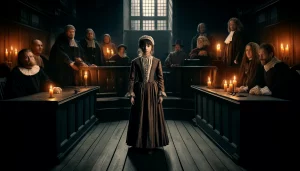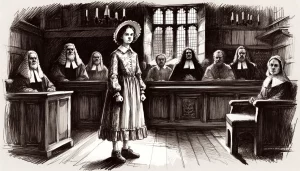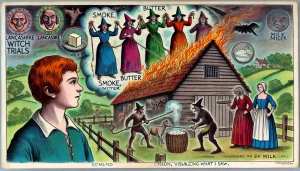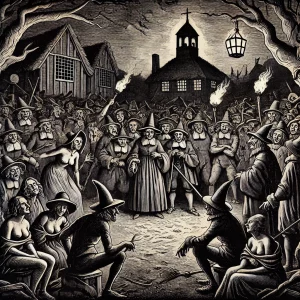The Chilling Child Testimonies of the Lancashire Witch Trials (1633-1634)
 Imagine living in a world where the innocent chatter of a child could condemn you to death. This was the terrifying reality in 1633 Lancashire Witch Trials, where nine-year-old Jennet Device’s testimony became the fulcrum upon which the fate of many balanced. A mere whisper from her could send you to the gallows, fuelling an atmosphere of fear and hysteria that gripped the entire community.
Imagine living in a world where the innocent chatter of a child could condemn you to death. This was the terrifying reality in 1633 Lancashire Witch Trials, where nine-year-old Jennet Device’s testimony became the fulcrum upon which the fate of many balanced. A mere whisper from her could send you to the gallows, fuelling an atmosphere of fear and hysteria that gripped the entire community.
The Lancashire Witch Trials of 1633-1634 were a profound episode of fear and superstition in 17th-century England. During a time when witchcraft was believed to be a genuine threat, communities were engulfed by paranoia. The trials in Lancashire were particularly notable for their reliance on the testimonies of children, which led to the execution of several accused witches. This blog post delves into the events of the trials, the influential figures involved, and the significant legislative changes that followed. How did the testimony of a young girl lead to such a tragedy, and what lessons were learned from this dark period in history?
Why Then, Why in Lancashire?
In the early 17th century, England was a land steeped in fear and superstition. Witchcraft was seen as a real and present danger, a threat to both spiritual and social order. King James I’s book, “Daemonologie,” published in 1597, had fueled the fire, encouraging the persecution of witches across the country. Lancashire, already notorious for its earlier Pendle Witch Trials in 1612, was a hotbed of superstition and tension. The region’s dark reputation and ongoing feuds between local families only served to fan the flames of hysteria.
The Trials Unfold
The Lancashire Witch Trials began in 1633 with the dramatic accusations of young Edmund Robinson. Robinson claimed he had seen two greyhounds transform into witches, who then led him to a gathering of sixty witches engaged in bizarre and sinister rituals. He described scenes of witches pulling on ropes to produce butter, milk, and flesh from thin air. His vivid and fantastical stories were taken seriously by the authorities, leading to a wide-reaching investigation and the arrest of many suspected witches.
 Jennet Device, whose testimony had been pivotal in the Pendle trials two decades earlier, again played a central role. At just nine years old, her statements were instrumental in condemning her neighbours and family members. Among those accused were Margaret Johnson, who confessed under duress, and Mary Spencer, whose fate was sealed by flimsy evidence and widespread paranoia. Another accused, the wife of James Loynd, was alleged to have transformed into a dog before Edmund Robinson’s eyes, illustrating the outlandish nature of some of the claims.
Jennet Device, whose testimony had been pivotal in the Pendle trials two decades earlier, again played a central role. At just nine years old, her statements were instrumental in condemning her neighbours and family members. Among those accused were Margaret Johnson, who confessed under duress, and Mary Spencer, whose fate was sealed by flimsy evidence and widespread paranoia. Another accused, the wife of James Loynd, was alleged to have transformed into a dog before Edmund Robinson’s eyes, illustrating the outlandish nature of some of the claims.
Robinson’s testimony was filled with vivid and frightening details. He claimed to have been taken to a house where witches were gathered, where he was given food and drink that he found suspicious. He also described seeing a group of witches in a barn pulling on ropes tied to the roof, which produced smoke, butter, and milk as they chanted and made “foul faces“. This testimony, full of fantastical elements, was enough to convince the authorities of the presence of witchcraft in the community.
The reliance on children’s testimonies was both unprecedented and controversial. The courts, swayed by the graphic and imaginative accounts of young witnesses, sentenced many to death based on these dubious claims.
Did You Know
The Lancashire Witch Trials were one of the few instances where children’s testimonies were pivotal, significantly influencing the outcome. This reliance on young witnesses set a dangerous precedent and highlighted the susceptibility of the judicial system to manipulation and hysteria.
Aftermath
The immediate aftermath of the Lancashire Witch trials was one of fear and suspicion. Communities were torn apart, and the public’s faith in the justice system was severely shaken. However, these events also prompted significant changes in legislation. The trials exposed the flaws in the judicial process, particularly the reliance on spectral evidence and the testimonies of children.
In response, the English legal system began to demand more concrete proof in witchcraft cases, moving away from spectral evidence. These changes marked the beginning of the decline of witch hunts in England, as courts required more substantial evidence to convict someone of witchcraft.
The Lancashire Witch Trials were a dark period in English history, demonstrating the dangers of mass hysteria and the misuse of judicial power. As historian Robert Poole aptly puts it, “The Lancashire trials were both a tragedy and a catalyst for change.” These events underscore the importance of a fair and rational legal system, and the perils of allowing fear and superstition to dictate justice.
Find Out More!
- The Lancashire Witches: Histories and Stories by Robert Poole.
- The Witch-Hunt in Early Modern Europe by Brian Levack.
- A comprehensive online resource detailing the Lancashire Witch Trials.


0 Comments